| Published
on 14
Oct
2008 |
All rights reserved.
|
|
|

|
Will Toyota finally realize the dream
that Smart has yet to fulfill ?
|
Toyota
said iQ is an innovative solution to our congestion and environmental
problems. Solution ? yes. Innovative ? Of course not ! Copying the
concept and styling of Smart and the 3+1 seating plan of the 2004 Fiat
Trepiuno concept car (which eventually became Fiat 500 but
unfortunately lost the innovative seating plan), the iQ is another
example of Japanese copycat. However, we know the Japanese are good at
improving and turning Western ideas into commercial success. Will
Toyota finally realize the dream that Smart has yet to fulfill ?
The iQ has about the same width and height as regular B-segment
superminis, but amazingly, it is just 3 meters long, or half a meter
shorter than Fiat 500. Smart Fortwo is shorter still at 2.7 meters, but
it carries only 2 people on board, where the little Toyota can take 3
adults plus a child.
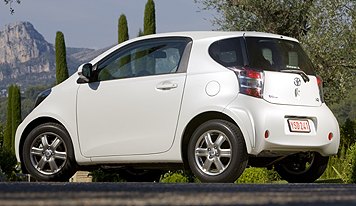
|
...just 3 meters long, or half a meter
shorter than Fiat 500.
|
Open the
doors, you
will
find the cabin of iQ unusually spacious for its size because of its
monobox profile, its generous width and its wheels locating right at
the corners. Toyota specially designed a differential which locates in
front of the engine so that the front wheels could be pushed as far
forward as possible. As a result, out of the 3 meters length, as much
as 2 meters is spent to the wheelbase to benefit interior space. More
space is saved by employing a flat fuel tank underneath the rear seat
and by using steeply angled suspension dampers. A thin dashboard (in
the expense of glovebox) and console (thanks to a small air-con)
intrudes little into the passenger space, so the front passenger seat
may slide forward enough for another adult sitting behind it. It won’t
accommodate two six-footers longitudinally, but two 5 ft 10in guys will
find comfortable enough for urban ride. Naturally, the driver occupies
more space, so behind him/her may sit only a child.
The
iQ
has zero boot space unless you fold down its rear seat. Given such a
short length, you can’t have a boot and rear seat simultaneously.
However, the short length doesn’t compromise safety. Toyota expects its
chassis can get 5-star Euro NCAP crash test rating, partly thanks to
the 9 airbags it provides as standard. For comparison, Smart Fortwo got
4 stars in Euro NCAP.
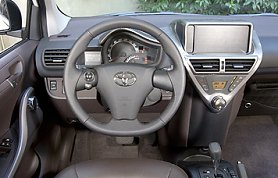
|
Slim dashboard design saves space,
though build quality hardly premium.
|
On the road,
the
baby Toyota drives like a bigger car. Its ride is far more compliant
than a Smart, while handling is reasonably faithful and predictable.
Body control and high-speed stability are much more satisfying than
Smart. Admittedly, given its longer wheelbase and very wide body you
should expect more. However, compare with a proper B-segment supermini,
the iQ isn’t so impressive. You will find it rolls too much in corners,
its steering light and lifeless, its energy-saving tires lack grip and
its ride quality acceptable at best. Its compact size compromises its
dynamics. The driver may complain for the lack of reach adjustment for
the steering wheel, and rear-quarter vision is blocked by the thick B
and C-pillars. On the positive side, you will find the little car very
easy to steer and to park in congested city, thanks to its small
turning circle. It also drinks little fuel and emits little greenhouse
gas…
The iQ offers 3 choices of engines. The first one is a 68 horsepower
1.0-liter VVT-i 3-pot which comes intact from Aygo. The second is a new
1329cc VVT-i inline-4 with 99 horsepower and fuel-saving automatic
start-stop function. The last one, Europe only, is a 1.4D4-D turbo
diesel that comes from Yaris, with an output of 90 horsepower. These
engines are quite high-tech in Japanese tradition, but they sound a
little vocal at high rev in the cabin of iQ. Transmission includes
5-speed and 6-speed manual (the latter for diesel engine) and an
optional CVT box.
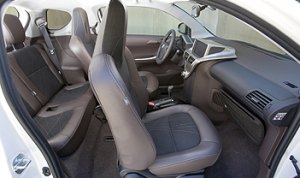
|
Cabin sits 3 adults and a child in
expense of luggage space
|
In theory, the
iQ
should deliver superior fuel economy and emission than its larger
European B-segment counterparts due to its smaller size, sophisticated
engines and a choice of CVT. In reality, it isn’t. Despite of its
smaller size, the iQ is no lighter than, say, a Fiat 500. Base model
starts at 845 kilograms and rises to 930 kilograms for a 1.3 CVT. The
continuously variable transmission is also disappointing for its low
efficiency, which results in 10 percent higher fuel consumption and
emission than the manual box. The following table compares the iQ with
some of the greenest European superminis:
|
CO2 emission
|
EU fuel economy
|
Max power
|
Smart Fortwo 800cc diesel
|
88 g/km
|
85.6 mpg
|
45 hp
|
Ford Fiesta 1.6TDCi Econetic
|
99 g/km |
76.3 mpg |
90 hp
|
Seat Ibiza Ecomotive 1.4D
|
99 g/km |
74.3 mpg |
80 hp
|
Volkswagen Polo 1.4D Bluemotion
|
99 g/km |
74.3 mpg |
80 hp |
Toyota iQ 1.0 VVT-i
|
99 g/km |
65.6 mpg |
68 hp |
Smart Fortwo 1.0
|
103 g/km |
65.6 mpg |
71 hp |
Mini 1.6D
|
104 g/km |
72.4 mpg |
109 hp |
Toyota iQ 1.4D4-D
|
105 g/km |
70.6 mpg |
90 hp |
Fiat 500 1.3 Multijet
|
111 g/km |
67.2 mpg |
75 hp |
Toyota iQ 1.3 VVT-i CVT
|
124 g/km |
54.3 mpg |
99 hp |
Mini One 1.4
|
128 g/km |
53.2 mpg |
95 hp |
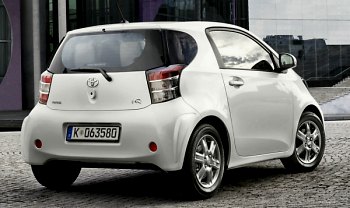
|
Smarter than Smart, but still
fails to beat conventional wisdom.
|
As seen, many
European superminis actually consume less fuel and emit less
carbon-dioxide than the baby Toyota yet without its compromised
accommodation, luggage space and dynamics.
Worse still, the unusual engineering of iQ requires a dedicated
platform and many unique components, so it costs more to build than
conventional superminis. As a result, Toyota tries to position it as a
premium niche model. Price in UK starts from £9,500 for the base
1.0 model, the same as a well-equipped Fiat 500. Compare the looks and
interior packaging of both cars, you will easily find which one is the
real premium niche car. And that is before you compare their driving
dynamics and usability. iQ might be smarter than Smart, but it still
fails to beat conventional wisdom. |
Verdict:    |
| Published
on 2
Jun
2011 |
All rights reserved.
|
|
Aston Martin Cygnet
|
|
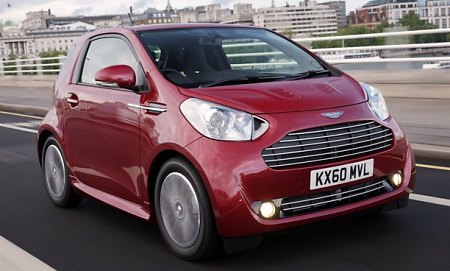
Two years ago, Aston Martin
shocked us by revealing the Cygnet. Derived from Toyota iQ, it was
easily the smallest and slowest Aston ever. We thought it was a late
April Fool's joke by Dr. Bez, but eventually it turns out to be reality
today.
Priced at £31,000 before options, you may see Cygnet as the
cheapest Aston ever or the most expensive mini car we ever know. Dr.
Bez doesn't care. He sees no reason to compare with mainstream city
cars because his customers will never consider them anyway. To Aston
Martin, the Cygnet is not a means to draw new customers or broaden its
customer base. It targets at the existing loyal customers of Aston. Bez
found many of them actually want a small, easy-to-drive car to commute
within the living area. Regarding price, the rich customers won't care
about £31,000 when they purchase a £150,000 Aston Martin,
just like how they snap up luxury watches and suitcases at Aston's
showrooms.
Sadly, the Cygnet is mechanically identical to the 1.3-liter iQ. Aston
did not even try to retune its ECU or install a low-restriction
exhaust, because that would have required type approval hence extra
costs that the project cannot afford. So what you get is the same
leisure performance (106 mph top speed and 0-60 mph taking 11.5
seconds) and civilized cornering dynamics. The only change is the use
of larger, 16-inch wheels instead of 15-inch items, and 60 percent
profile tires instead of 65 percent. It barely rides a tad firmer than
the Toyota. That's all.
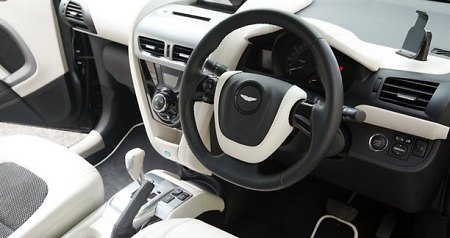
What Aston cares are purely cosmetic – the trademark front grille, hot
air outlets at both sides and on the bonnet (all are pseudo), cosmetic
extension of the headlamps, new taillights and bespoke wheels. These
changes necessitate the replacement of all body panels bar the roof. In
the cabin, the fundamentals are the same as iQ but Aston wrapped it
with hand-stitched leather, Alcantara and some bespoke switchgears.
Like other Astons, the production is human-intensive. It takes 150
man-hour to modify the iQ into Cygnet, not far off the 200 man-hours
required to assemble DB9. Nevertheless, you can still easily see its
Toyota roots, such as the cheap plastic dashboard behind the leather.
It looks like a half-baked bread. From this view, the £31,000
investment seems less satisfying than a luxury watch.
As many people pointed out, the Cygnet is a trick to lower Aston
Martin's fleet average CO2 emission.
That's how it was conceived. However, as the new EU regulation
eventually approved in 2009 allows niche car makers with annual sales
less than 10,000 units to exempt from the 130g/km limit and apply for
reasonable reduction targets instead, the call for a small car is no
longer urgent. (Hopefully I will take some time to explain the
regulation to our readers) Now it becomes more a marketing gimmick, or
a toy to the very richest.
|
Verdict:   |
|